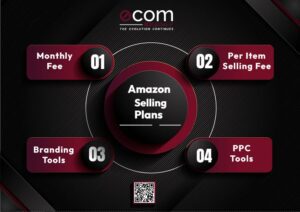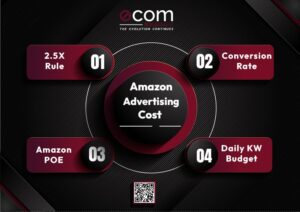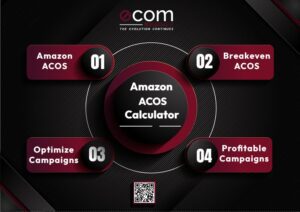
Have a great time reading this blog.
Ready to see how our team can grow your Amazon brand? Click Here
.box {
position: relative;
padding: 15px;
font-size: 16px;
color: #62668A;
background-color: rgba(255, 100, 100, 0.05);
}
.box::before {
content: "";
position: absolute;
top: 0;
left: 0;
width: 100%;
height: 100%;
background-color: rgba(100, 15, 37, 0.05);
z-index: -1;
}
.text {
font-size: inherit;
}
.first-sentence {
font-size: 16px;
font-weight: bold;
}
.second-sentence {
font-size: 14px;
}
.text .link {
text-decoration: none;
color: #640F25;
font-size: 14px;
font-weight: 500;
}
/* Responsive font size for mobile devices */
@media (max-width: 767px) {
.box {
font-size: 15px; /* Reduce font size by 1 point for mobile */
}
.first-sentence {
font-size: 15px;
}
.second-sentence {
font-size: 13px;
}
.text .link {
font-size: 13px;
}
}
Have a great time reading this blog.
Ready to see how our team can grow your Amazon brand? Click Here
How to Start an Ecommerce Business on Amazon (2024): Step-by-Step Guide
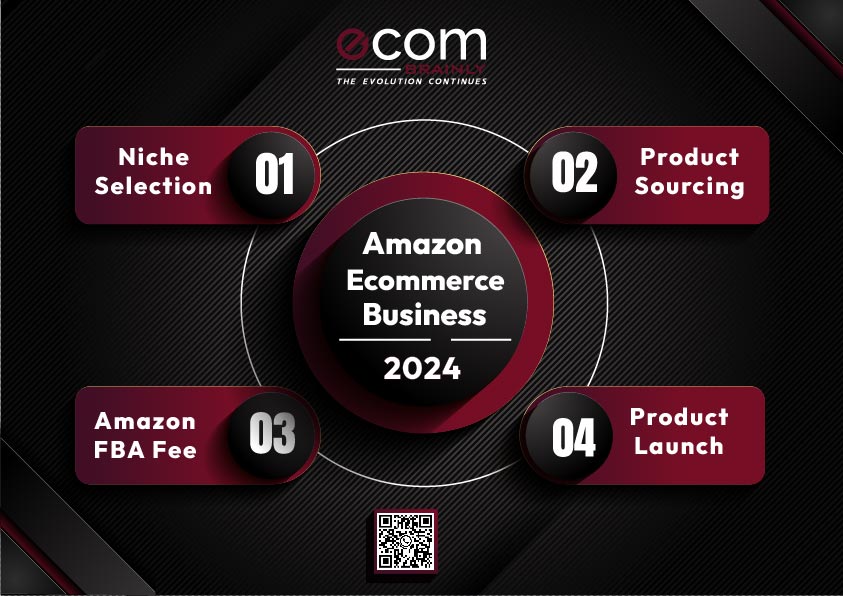
How to Start an Ecommerce Business on Amazon: Introduction
E-commerce has rapidly transformed into a global phenomenon, reshaping consumer interactions with products and services. Traditional shopping norms have given way to online transactions, seamlessly integrating into our daily lives.
As we explore a step-by-step guide on how to start an ecommerce business on Amazon, it’s essential to understand the expansive scope of e-commerce. In this ever-connected world, navigating the e-commerce landscape requires a keen awareness of its dynamic nature
Why You Should Start an Ecommerce Business on Amazon?
In the era of e-commerce, launching an Amazon store stands out as a beacon of opportunity. The platform’s vast reach and esteemed reputation pave the way for success.
With millions of potential customers at your fingertips, stepping into this marketplace isn’t just a venture; it’s an entry into a dynamic and flourishing ecosystem.
Your journey here is an immersion into a marketplace that never sleeps, where your brand can shine with the expertise and authority that comes with Amazon’s trusted platform.
You Might Be Interested In
Overview of the Comprehensive Guide
This guide is like your roadmap to start selling on Amazon. We’ll walk you through each step, so you’re all set to make smart decisions.
Follow the simple tips, and we’ll help you turn your business dreams into reality. Trust the guidance we offer, and let’s make your journey to success on Amazon straightforward and achievable.
Understanding the Amazon Marketplace
1. The Vast Customer Base
When it comes to starting an ecommerce business on Amazon, one of its most compelling aspects lies in the platform’s unparalleled reach. Amazon transcends being just a website; it serves as a global marketplace that seamlessly connects millions of buyers and sellers spanning every corner of the world.
Regardless of whether your niche is highly specialized or broadly appealing, Amazon provides a marketplace where your products can find eager buyers. The sheer volume of daily visitors to the platform creates an environment rich with opportunities.
Launching an Amazon store positions you strategically to showcase your offerings to a multitude of potential buyers actively seeking products similar to yours.
2. Different Types of Amazon Selling Accounts
As you contemplate starting an Amazon store, it’s important to understand the different types of selling accounts available on the platform. Amazon offers two primary options: Individual and Professional selling accounts.
1. Individual Selling Account: This account type is suitable for those who plan to sell a limited number of items. It involves a per-item fee, making it a practical choice for sellers with a modest inventory.
2. Professional Selling Account: If you’re serious about growing your business and anticipate a higher volume of sales, a Professional selling account is the way to go. It involves a monthly subscription fee but provides advantages like bulk listing and access to additional tools.
3. Pros and Cons of Selling on Amazon
Deciding on starting an Amazon store requires a balanced consideration of the pros and cons. Here’s a glimpse of what you can expect.
Pros:
Massive Exposure: Amazon’s vast user base ensures your products are exposed to a massive audience.
Streamlined Logistics: Utilizing Amazon’s fulfillment services can ease the complexities of order processing and shipping.
Customer Trust: The Amazon brand is synonymous with trust, boosting credibility for your products.
Amazon Prime Benefits: As an Amazon seller, you can tap into the Prime membership base, offering your products with faster shipping options.
Cons:
Competition: The popularity of Amazon attracts a significant number of sellers, leading to competition in almost all niches.
Amazon Fees: While exposure is vast, fees such as referral fees and fulfillment charges are part of the equation.
Niche Selection and Product Research
1. Identifying Your Passion and Expertise
When you’re in the early stages of starting an Amazon business, it’s crucial to begin with what you know and love. Focus on products within your area of expertise, rather than depending solely on data. Your distinctive background and proficiency provide a competitive edge over those who merely hinge on data patterns.
Consider a scenario where a seasoned chess player marketing chess boards could surpass a data guru chasing fleeting trends. Have confidence in your personal insights and business insight when making strategic choices
2. Evaluating Market Demand and Competition
Your chosen niche should not only align with your passion but also show promise in terms of demand and manageable competition. Conduct thorough market research to assess these factors:
1. Market Trends: Is your chosen niche experiencing a noticeable upward trajectory, or downward? Consistent and continuous growth within your niche is a reliable indicator of a robust and thriving market environment.
2. Keyword Analysis: Take advantage of tools like Helium 10 and JungleScout to look at how often people search for keywords related to your niche. When you see a lot of searches, it means there’s a big demand for what you’re offering.
3. Competitor Analysis: Take some time to study your competitors. Are there any areas in the market that they haven’t covered yet? Look closely at what they’re good at and where they might be lacking. This will help you identify opportunities to stand out.
3. Product Research Methods
If you’re deeply passionate about a product you wish to sell, or you’re the owner of a brand with an extensive product range, you might find yourself fortunate to bypass this particular step.
However, for those starting without a specific product in mind and aiming to start from scratch, the essential route involves going into the phases of product research and evaluation.
Amazon Product Research Methods” refers to the various systematic approaches and techniques used to gather valuable information and insights about products available on the Amazon platform.
These methods are employed by sellers and entrepreneurs to make informed decisions when selecting, launching, and marketing their products on Amazon
1. Amazon Best Sellers: Explore Amazon’s Best Sellers list to identify what’s currently popular in your niche. This gives you insights into products that consistently perform well and helps you understand customer preferences.
2. Amazon Search Bar: Utilize Amazon’s Search Bar to discover what customers are actively searching for. As you type, auto-suggestions reveal popular keywords, giving you direct insights into customer interests.
3. New Releases: Keep an eye on the “New Releases” section to discover recently launched products in your niche. This allows you to stay ahead of the curve and consider innovative ideas that cater to evolving customer needs.
4. Using Tools for Smart Research: Employ tools like Helium 10 and Jungle Scout for thorough product research. These tools analyze keyword trends, competition, and historical data, helping you make informed decisions based on accurate market insights.
4. Example Product Research & Analysis:
Let’s imagine you’re a candle maker looking to sell candles on Amazon. Among the various types available, you’re particularly interested in selling “Floating Candles.
- Start by assessing product demand: Check Amazon’s search volumes for “Floating Candles that has 15,000 search volume indicating a strong demand.
- Analyzing the product market: Identify successful variations, such as a pack of 50 Floating Candles priced at an average of $19.99.
- Identify competitors: Locate main competitors (C1, C2, C3) selling packs of 50 candles on the first search results page as shown in image below.
- Analyze competitors: Examine strengths and weaknesses of competitors to inform strategic decisions.
- Pinpoint weaknesses: Critical analsysis reveals opportunities to enhance your product and offer a more attractive option to customers.
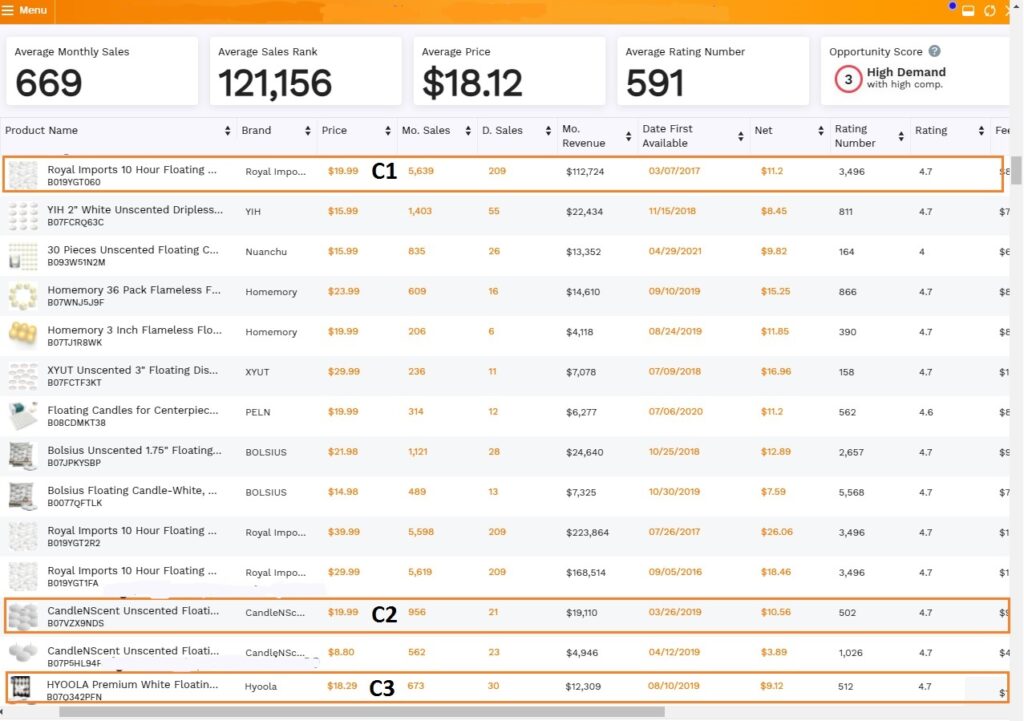
Setting Up Your Amazon Seller Central Account
When you’re considering how to start an ecommerce business on Amazon, the initial crucial step is setting up your seller account. Here’s a simplified step-by-step guide to help you begin.
1. Visit Amazon Seller Central: Go to sellercentral.amazon.com and click “Register Now.”
2. Choose Account Type: Select between Individual or Professional selling plans. The former is suited for low-volume sellers, while the latter is ideal for businesses with higher sales volume.
3. Provide Personal Information: Enter your email, password, and business name (if applicable).
4. Enter Business Information: Input your business address, phone number, and bank account details for payments.
5. Verify Identity: Amazon may require identity verification through phone or credit card.
6. Product Category Selection: Choose the product categories that align with your offerings.
7. Set Up Payment: Enter your preferred payment method for Amazon fees.
Congratulations! Your Amazon seller account is now set up.
1. Individual and Professional Selling Plans
As you set up your Amazon seller account, understanding the differences between Individual and Professional selling plans is essential:
1. Individual Selling Plan: Ideal for low-volume sellers, it involves per-item selling fees. Suitable if you’re testing the waters or have a limited inventory.
2. Professional Selling Plan: Geared toward businesses with higher sales volume, it requires a monthly subscription fee but offers advantages like bulk listing and access to additional tools.
Choosing the right plan depends on your business goals, projected sales volume, and budget.
As you progress in starting an Amazon store, a well-structured seller account and a clear grasp of its functionalities lay the foundation for effective store management and growth.
Read our latest blog for a detailed analysis of Amazon SEO Optimization in 2024: Amazon SEO Optimization Tips and Trends in 2024
Sourcing and Creating Your Products
1. Different Product Sourcing Options
When starting an Amazon FBA business, the products you offer are at the core of your business. Exploring various sourcing options can help you find the right fit for your brand.
- In Amazon Private Label business, finding the right products is crucial. Start by figuring out how much to sell your product for.
- A smart strategy is to source products at a cost 20% to 30% below what your competitors charge on average. This approach gives you room to navigate in a competitive market and sets the stage for your brand to succeed.
- This strategy also lets you allocate resources strategically, especially for higher-cost Amazon Pay-Per-Click (PPC) campaigns. This boosts visibility and improves your chances of making a mark in the market.
Here are several online sourcing websites we rely on to acquire our products:
Alibaba: A global giant, Alibaba provides an extensive range of products and suppliers. Its user-friendly interface and vast network make it a prime choice for sourcing diverse Amazon products.
Global Sources: This platform boasts a curated selection of verified suppliers. With its emphasis on quality and innovation, Global Sources is an excellent resource for unique and trending Amazon merchandise.
Made-in-China: Focused on connecting international buyers with Chinese suppliers, Made-in-China offers an array of product categories, making it suitable for a variety of Amazon niches.
DHgate: DHgate specializes in smaller quantities and one-off purchases. It’s ideal for testing products or sourcing smaller batches before committing to larger orders.
1688: Operated by Alibaba Group, 1688 is a popular choice for Amazon sellers looking for competitive prices, especially for bulk orders.
AliExpress: Known for its convenience and ease of use, AliExpress is a retail platform offering smaller quantities, making it suitable for sellers who prefer lower volume sourcing.
These platforms simplify the process of finding quality suppliers, negotiating deals, and obtaining the right products for your Amazon business, contributing to your success as an Amazon seller.
2. Example Product Sourcing
- Let’s say we have a product named “Floating Candles” that we have searched to launch on Amazon.
- When we needed to find “Floating Candles” for our business, we headed over to Alibaba.
- There, we searched for our product and found the best manufacturers.
We reached out to different suppliers and made sure they were verified and responsive. - After some discussions, we managed to get a good price of $3 from various suppliers.
- With this price in hand, we took the time to figure out all of Amazon’s fees and costs, so we could accurately calculate how much profit we’d make.
- Our goal is to have at least a 30% profit margin.
- To achieve this, we set our product price 20%-30% lower than our competitors.
This way, we make sure our business remains competitive while still making a healthy profit.
Pricing Strategy, Profit Margins, and Fulfillment Options
1. Pricing Strategies
Effective pricing is a delicate balance. When starting a brand on Amazon, consider these strategies:
1. Competitor Analysis: Study your competitors’ prices and adjust yours accordingly to remain competitive. We ensure that our price is set at least 20% lower than the competition while maintaining a profit margin of 30% or more.
2. Value-Based Pricing: Base your pricing on the distinctive value your product brings to customers. Consider its unique benefits and features to create an appealing and competitive price point.
2. Fulfillment by Amazon (FBA) and Fulfillment by Merchant (FBM)
When starting an Amazon store, you have two primary fulfillment options:
1. Fulfillment by Amazon (FBA): Amazon handles storage, packing, and shipping. Benefits include Prime eligibility and enhanced customer trust.
2. Fulfillment by Merchant (FBM): You manage order fulfillment. This option may offer more control over the process and potentially lower costs.
Consider your business’s size, volume, and resources when choosing the most suitable fulfillment method. Strategic pricing, sound profit margins, and selecting the right fulfillment approach are essential components of your business’s financial success.
3. Calculating Costs and Setting Profit Margins
Profit margins are vital for your Amazon business’s financial health. Consider prices such as the product’s sourcing costs, shipping charges, fulfillment fees, bank charges (2%-4%), and other associated charges. This ensures accurate insights tailored to Amazon’s dynamic marketplace.
1. Cost of Goods Sold (COGS): Include manufacturing, shipping, and packaging costs.
2. Amazon Fees: Account for referral fees, fulfillment fees, and storage fees.
3. Operating Expenses: These costs include overhead costs such as marketing and 3PL storage costs.
Below, you’ll find a comprehensive breakdown of the Amazon FBA fees for your reference:
Amazon FBA Fee:
As a seller utilizing Amazon’s FBA service, the advantage lies in the elimination of shipping, handling, and packaging expenses for sending out your products. Amazon’s proficient fulfillment team takes charge of the picking, packing, and shipping process on your behalf.
To account for these operations, Amazon applies seller fees, calculated according to the dimensions and weight of your items.
Here, we provide illustrative charts outlining the current FBA fees set by Amazon in 2024 for your convenience:
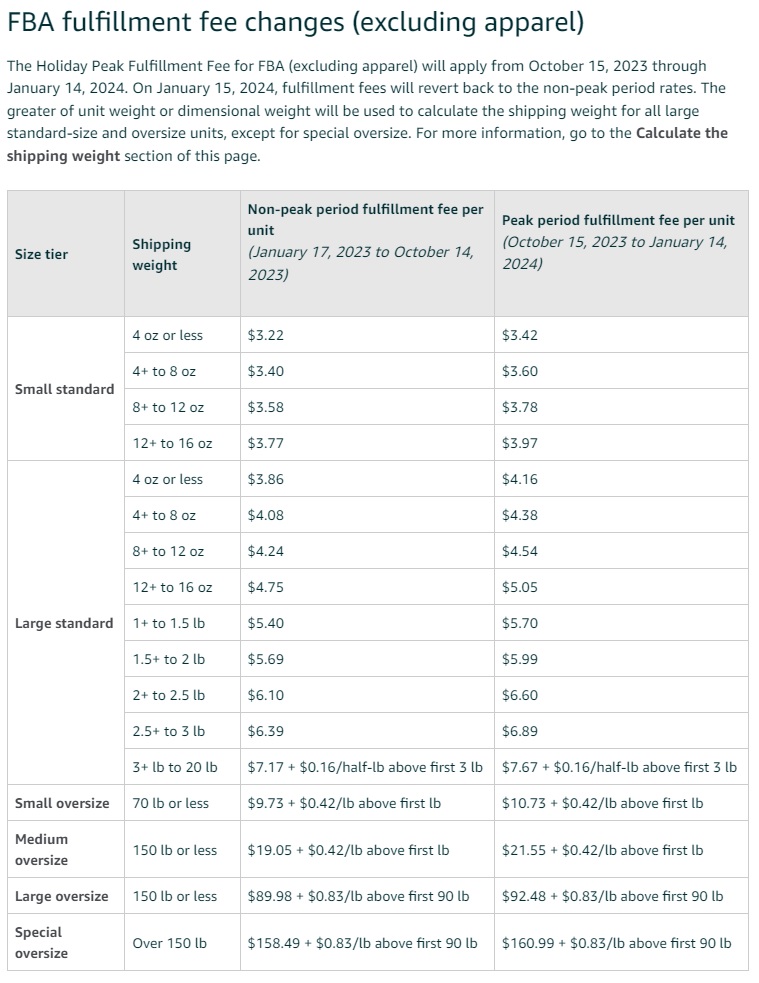

4. FBA Storage Fees
Given that your product is housed within Amazon’s fulfillment centers, they apply storage fees to ensure the upkeep of your inventory. When your products are in an Amazon warehouse at the close of the month, you’ll encounter a monthly storage fee.
This charge is either deducted from your account balance or added to your credit card if your Amazon account lacks the funds to cover the fee.
5. Amazon Low-Price FBA Program
Fulfillment by Amazon (FBA) Small and Light program offered sellers the option to enroll their small, light, and budget-friendly products. This allowed them to benefit from reduced FBA rates, although at the trade-off of slower shipping speeds compared to standard FBA.
Commencing in August 2023, Amazon has introduced a transformation by discontinuing the Small and Light program and introducing new regulations.
Under these updates, any product priced below $10 will now benefit from reduced FBA fees in comparison to the standard FBA rates. The updated FBA rates for low-price products will reflect an average reduction of $0.77 per item compared to the existing FBA rates applicable to these items.
A detailed breakdown of the revised FBA rates for items priced below $10 is visually represented in the image below:

6. Example Amazon Fees and Profitability
- Let’s revisit the previous example of “Floating Candles.”
- Initially, we secured a manufacturing cost of $3 for this product.
- Now, let’s delve into a profitability calculation that accounts for all associated Amazon fees.
- With our product weighing 5.3 lbs, referring to the Amazon FBA fees section reveals a corresponding fee of $7.97.
- Similarly, we factor in the referral fee, set at 15% (Amazon fixed fee) of our selling price, along with the storage fee.
- Upon meticulous computation, our ultimate profitability stands at 24%, as depicted in the image below.
- However, our goal remains a targeted profitability of 30%.
- To align with this objective, adjustments are required.
- This involves engaging in negotiations with our supplier to lower the manufacturing price until we successfully attain our desired target.

Private Labeling and Branding Considerations
Private labeling offers you the remarkable opportunity to introduce products bearing your unique brand identity to the market.
This approach enables you to source high-quality items from manufacturers and then affix your brand name, logo, and distinctive packaging to them. Consider these steps:
1. Product Customization: Add unique features or design elements to differentiate your product from your competitors.
2. Branding Elements: Create a compelling brand name, logo, and packaging design that resonates with your target audience.
3. Quality Control: Make sure the products you put your brand name on are of high quality. This is important for building trust and a good reputation. It also affects how customers review your product on Amazon. So, always aim to launch a product that is really good.
1. How to Ensure Product Quality and Packaging
Ensuring the quality of your products is absolutely crucial when you’re beginning your Amazon store. It’s a top priority that should never be compromised.
1. Sample Testing: Request product samples multiple times before placing purchase order with your supplier to assess quality.
2. Supplier Verification: Verify supplier credentials and reputation through research and due diligence.
3. Packaging Excellence: Invest in sturdy, visually appealing packaging that protects your products during shipping and enhances customer experience.
The products you provide are a direct representation of your brand, making every step – from careful sourcing to private labeling and stringent quality control – integral to your triumph as you embark on your Amazon store journey.
Creating SEO Optimized Product Listings
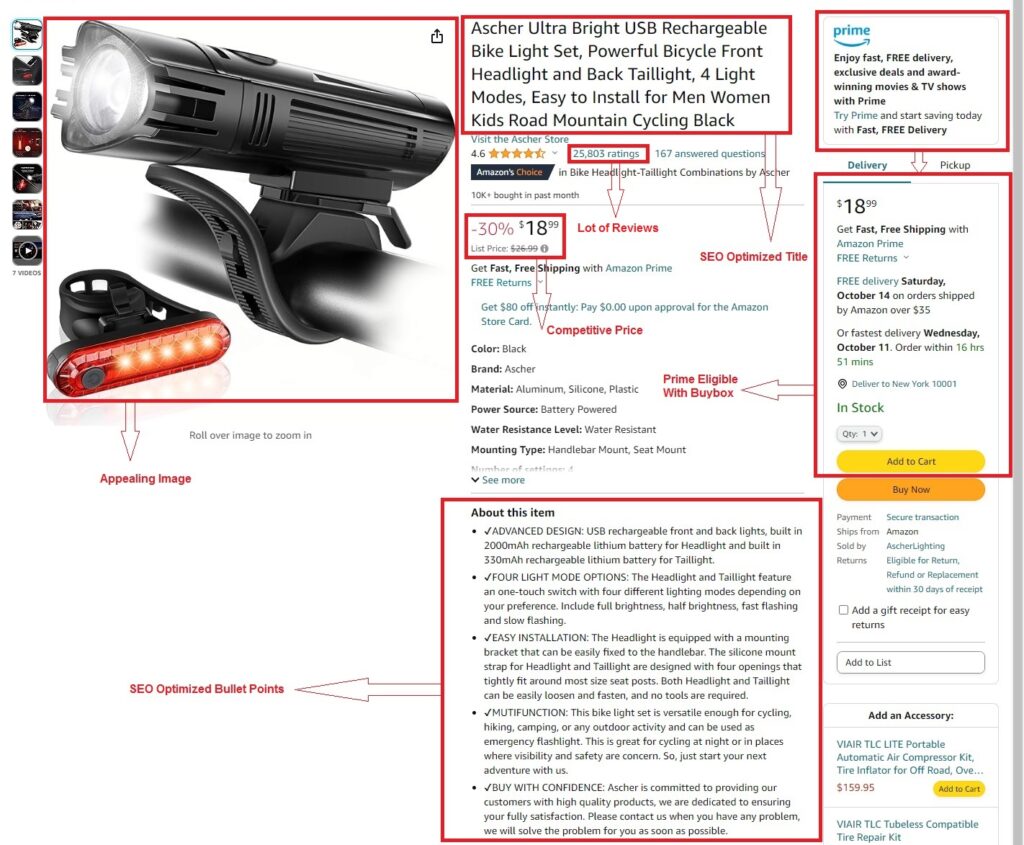
1. Keyword-Optimized Titles, Bullet Points and Descriptions
As you go forward on your journey to start an ecommerce business on Amazon and establish an Amazon store, your product listings become the virtual storefront through which customers engage with your brand.
These listings hold the key to your visibility and conversion rates. To optimize the impact of these listings, focus your attention on the following critical elements:
1. Keyword Research:Identify the keywords that customers often use when they’re looking for products on Amazon. You can make this process easier by using tools like Helium10 or DataDive. Build a comprehensive list of these significant keywords for your product to help you reach more potential buyers effectively.
2. Title Optimization: Craft clear, concise titles that include primary keywords, brand, and key product attributes.
3. Engaging Bullet Points: Craft persuasive bullet points to inform and engage your buyers. Ensure to address the specific problems your product can solve for them..
3. Engaging Descriptions: Write compelling, informative descriptions that highlight benefits and features, using keywords naturally.
Read our latest blog for a detailed analysis of Amazon SEO Optimization in 2024: Amazon SEO Optimization Tips and Trends in 2024
2. Product Images and Creatives
High-quality images are your products’ first impression. Consider these strategies:
1. Professional Photography: Invest in professional product photography to showcase your products effectively. Display your product from various angles to provide a comprehensive view. Create infographics or lifestyle images to illustrate product usage and benefits.
2. Amazon A+ Content Design:
Incorporate Amazon A+ Content Design to enhance your product listings. This feature allows you to go beyond basic product details, using visuals and narratives to provide a more engaging and informative experience for potential customers.
See the example of a well crafted Amazon premium A+ content below.

Explore this article to discover effective strategies for crafting top-notch A+ content for your brand: Master Amazon A+ Content: Key Design Tips for Success!
3. Amazon Brand Story Design:
With Amazon Brand Story Design, you shape a distinct brand identity. This involves crafting a compelling brand story, values, and mission to create a meaningful connection with your audience, setting your brand apart on Amazon.
See the example of a well crafted Amazon Brand Story below.
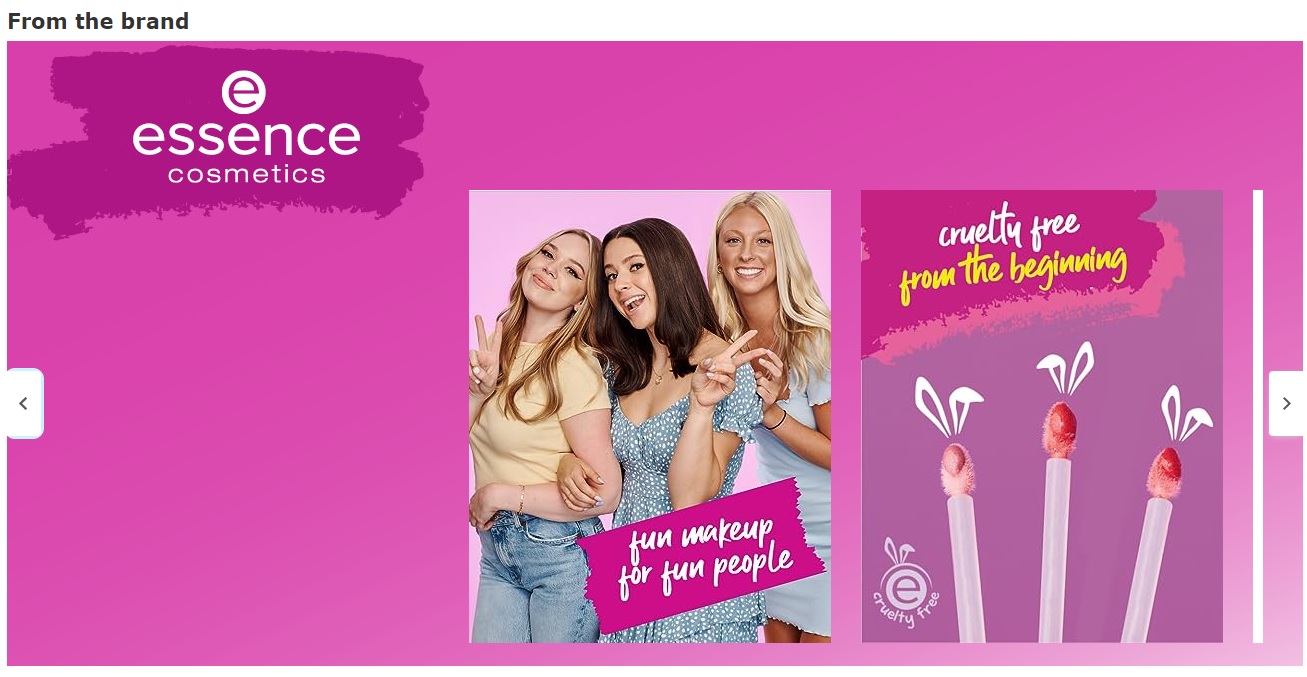
Launching Your Amazon Store
1. Comprehensive Product Launch Plan
Launching a new product and understanding how to start an ecommerce business on Amazon is like embarking on an exciting journey. The Comprehensive Product Launch Plan, which includes smart strategies for a successful launch, serves as your trusted map throughout this process.
Before sending your first batch of products to Amazon’s fulfillment center, there are some important things to prepare. Make sure you have everything ready, like photographs of your products, A+ content, product videos, master keywords list, and listing content. You also need to separate these keywords for Amazon Advertising, which helps your product rank on the first page of Amazon.
Remember, at each stage, you’ll study your niche, competitors, pricing, and profit margins. This helps you stay informed about any important changes in your product’s market. Throughout this journey, it’s essential to be careful with your profit margins. They will have a big impact on your Amazon experience.
As you move forward, it’s crucial to have a proper launch plan. Decide whether you’ll focus only on Amazon Advertising or if you’ll also bring in customers from other places like Google or TikTok. Planning and using the Comprehensive Product Launch Plan will help you navigate this journey successfully.
2. Utilizing Amazon PPC Advertising
Amazon offers advertising tools to enhance visibility:
1. Sponsored Products: Amazon Sponsored Products is a program that lets you make your products stand out by using specific keywords. Your product appears in search results, and you pay only when people click on your ad.
2. Sponsored Brands: Amazon Sponsored Brands showcases your brand’s logo, headline, and products. It directs customers to your brand’s page, helping you tell your story and boost sales.
3. Sponsored Display: Amazon Sponsored Display expands your reach beyond Amazon, showing ads on various websites. You can target specific audiences, increasing brand exposure and engagement.
Gain valuable insights on Amazon PPC strategies by checking out our recent blog post: Amazon PPC Strategy: 3 Winning Strategies to Drive More Sales in 2024
3. Example Amazon Product Launch Strategy
Before launching the “Floating Candles” product, let’s ensure that all essential steps are meticulously executed:
1. Inventory Placement:
Strategically plan and execute the Amazon shipment plan to send the initial inventory to Amazon’s warehouse, ensuring a smooth stock availability for launch.
2. Keyword Research:
Utilize Helium10 to identify pertinent keywords specific to floating candles, enabling optimal product visibility.
3. SEO Optimized Listing Creation:
Craft a comprehensive listing, comprising high-quality product images, a captivating title, impactful bullet points, and an engaging description. Incorporate A+ content for enhanced indexing and appeal.
4. Storytelling with A+ Content:
Develop captivating A+ content and brand story that resonates with potential buyers. Submit the content for approval to Amazon to enhance the product’s narrative and allure.
5. Visual Impact with Product Videos:
Create and upload informative product videos to the listing, offering customers a dynamic and immersive view of “Floating Candles”.
6. Strategic Keyword Segmentation:
Carefully organize and categorize keywords for Amazon Advertising. For targeted Amazon PPC campaigns, separate the top 15 highly relevant keywords to maximize visibility.
7. Continuous Analysis:
Continuously monitor and analyze the product’s niche, competitive landscape, pricing strategies, and profit margins. Stay informed about any significant changes that might impact your product’s success.
8. Profit Margin Preservation:
Strategically manage and conserve profit margins at each stage of the launch journey. Thoughtful margin preservation ensures a stable foundation for the product’s growth and sustained success.
Amazon Advertising Strategy
As Amazon begins to receive our inventory, we shift our focus towards an effective advertising strategy. On the day of the grand launch, our Amazon PPC campaigns are thoughtfully structured as follows:
1. Sponsored Products – Exact Match:
Launch three (03) exact campaigns, each containing up to five carefully selected keywords with 30%-50% Top of the Search placement.
2. Sponsored Products – Broad and Phrase Match:
Mirroring the approach, we create three (03) campaigns for broad and phrase match types. Each campaign incorporates a maximum of five targeted keywords, optimizing reach and relevance.
3. Sponsored Products – Auto Campaigns:
Implement an auto-close and an auto-loose campaign, allowing Amazon’s algorithms to search potential high-converting keywords.
4. Sponsored Brands – Video Ad:
A Sponsored Brands Video ad, designed to captivate audiences, is strategically curated with our top five keywords. This visually engaging format elevates product awareness.
5. Sponsored Brands – Headline Ads:
Complementing the strategy, a Sponsored Brands headline ad generates awareness about your product, leaving a distinct imprint in customers’ minds.
Promotions and Discounts
A successful launch can propel your products. Consider these launch strategies:
1. Amazon Vine Program: Amazon Vine Program designed to help new products gather genuine reviews from Amazon own network of product reviwers.
2. Limited-Time Discounts: Offering time-limited discounts on your products to entice customers, driving increased sales and creating a sense of urgency to make a purchase. Offer discounts to 20%-30% to get maximum visibility and sales.
3. Social Media Marketing: Leveraging social media platforms to reach and engage potential customers, sharing product highlights, customer stories, and promotions to generate interest and sales.
4. Amazon Prime Exclusive Discounts: Offer exclusive discounts for Amazon Prime members, strategically timed for major events like Amazon Prime Day, Black Friday, and Cyber Monday. Boost visibility, attract new customers, and create a sense of urgency to drive sales during these high-traffic periods.
Managing Inventory and Order Fulfillment
Among the crucial elements in your Amazon journey, effective inventory management stands tall. A cardinal rule in Amazon selling is to uphold the principle of “Never Go Out of Stock.” Employ these strategies meticulously to safeguard against inventory shortages:
1. Strategic Restocking:
Utilize historical sales data and demand trends to predict stock needs accurately. Timely replenishment ensures a consistent supply for customers.
2. Buffer Stock Planning:
Create a buffer by maintaining a safety stock that acts as a safeguard against unexpected surges in demand, avoiding stockouts.
3. Dynamic Monitoring:
Employ advanced tools to monitor inventory levels in real-time, enabling swift action to restock before supplies run critically low.
4. Seasonal Preparedness:
Anticipate seasonal fluctuations and plan ahead to ensure ample stock availability during peak demand periods.
5. Supplier Collaboration:
Foster strong communication with suppliers, ensuring seamless coordination to meet supply demands promptly.
6. Optimized Reordering:
Implement automated reorder triggers based on predetermined thresholds, streamlining the restocking process.
Optimizing for Long-Term Success
1. Monitoring Key Performance Metrics
When navigating the dynamic landscape of Amazon, monitoring key performance indicators (KPIs) becomes paramount. These metrics provide valuable insights into the health and progress of your business, enabling informed decisions and targeted strategies. Among the critical KPIs to focus on are:
- Tracking your sales and revenue is fundamental. It offers a clear picture of your business’s financial performance, aiding in gauging profitability, identifying trends, and setting growth targets.
- Monitoring your conversion rate is pivotal. This metric reflects the effectiveness of your product listings, imagery, pricing, and overall customer experience. A higher conversion rate indicates that your product pages resonate well with shoppers and entice them to make a purchase.
- Dive into Amazon Advertising KPIs, including Click-Through Rate (CTR), Return on Ad Spend (ROAS), and Impression Share. However, one crucial metric to highlight is TACoS (Total Advertising Cost of Sales). TACoS is a measure of ad efficiency, indicating the ratio of your advertising spend to the revenue generated from your ads. A lower TACoS signifies more efficient advertising campaigns, where you are spending less to generate more sales.
- By vigilantly observing these KPIs, you gain a comprehensive understanding of your Amazon journey’s dynamics. Utilizing this data-driven approach empowers you to make data-backed decisions, refine your strategies, and ultimately elevate your Amazon business to new heights.
2. Using Insights to Improve Your Amazon FBA Business Strategy
Discover how the power of insights can transform your Amazon venture, refining your approach for sustainable growth and success:
1. Experimentation: Experiment to find what your customers like best. Testing different ideas helps you make your strategies better.
2. Market Trends: Stay updated on what’s popular in the market. Changing your products to match what customers want helps your business stay successful.
3. Competitor Analysis: Watch what your competitors are doing. This helps you make good choices and be better than them.
By leveraging data, embracing customer feedback, and staying agile in your business approach, you can optimize your Amazon store for sustained success. This commitment to continuous improvement will guide your journey as you navigate the complexities of starting an ecommerce business Amazon and strive for long-term excellence.
Ecom Brainly: Your Path to Amazon Ecommerce Success
Wondering how to start an ecommerce business on Amazon? While setting up an Amazon business requires a comprehensive approach. To thrive on Amazon, you must have rock solid Amazon product launch strategy.
At Ecom Brainly, we specialize in guiding Amazon sellers through setup and launch brands on Amazon. Our expertise helps you navigate starting an ecommerce business on Amazon and achieving growth.
Connect with us online to explore our specialized services for Amazon businesses!
Share This Article

About Ecom Brainly
Ecom Brainly – A Full-Service Amazon agency that focuses on Sustainable Growth and Profitability for Our Partners (clients).
We been selling on Amazon since 2017 and has had to adapt for every change that Amazon has made along the way. Amazon is an ever changing marketplace and Ecom Brainly has his team ready to handle any and every challenge.
Is your brand having challenges with growth, profitability, advertising, reporting etc – If yes, please contact us today!
Agency Services
Case Studies
Related Posts
